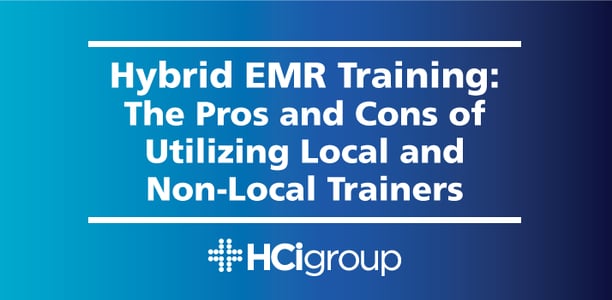Hybrid EMR Training: The Pros and Cons of Utilizing Local and Non-Local Trainers


There are certain personality traits, skillsets, and backgrounds that must be looked at in order to decide on the perfect trainers for your EMR Training project. Obviously, it is preferred that all of your trainers have some sort of training experience in their background, but this is not always the case. There will be times when your organization will have to rely on a combination of both experienced trainers and local trainers.
HCI’s Jake Morrison has worked within the HCI hybrid training program, and knows the benefits and downsides of using a combination of both experienced and local (typically inexperienced) trainers. In today’s blog post, he goes over the benefits and downsides to utilizing local trainers in conjunction with your experienced trainers.
1) Benefits of a Hybrid Training Program
One of the major benefits of using local trainers is that there will be more of a sense of community focus. Clients can continue to focus on patient care while you begin to recruit local community members to join your credentialed training team. It is often encouraged to hire multiple inexperienced resources at no cost, in a model similar to a “temp-to-perm” model – this gives you time to work with the resource before making the decision to hire them.
Local trainers, being much less experienced, tend to see opportunities like this as ways in which they can learn and excel in their careers. These inexperienced resources tend to have a greater drive to succeed due to the fact that they see your project as an opportunity to get hired on by the local health system, which can result in less attrition down the road. In addition, the increased motivation from your local trainers will lead to your experienced resources feeling the need to surpass expectations – a model that tends to create a friendly competition between the two groups. When partnering a local inexperienced resource with an experienced one, it is common to see the experienced resource making it a personal goal for the inexperienced resource to succeed, which can create a cohesiveness between the two.
2) Downsides to a Hybrid Training Program
No matter what you do or how you plan, expect there to be at least some degree of attrition. It is not uncommon for experienced resources to feel threatened when inexperienced local resources are brought in. When an organization brings in an inexperienced resource and tells them they will be doing the same exact job as the experienced resources after six short weeks, it can be intimidating. It is also not uncommon for some of these local inexperienced resources to not be ready to credential after this short amount of time.
Another issue that can sometimes arise when utilizing inexperienced local trainers is that they may have some trouble relating to end users at go-live. While they may have become excellent teachers, your inexperienced resources still have only seen a very limited aspect of EMRs – some may have only seen one instance of Epic, for example, and will have a hard time relating to an end user who is used to how certain aspects or modules operate in their legacy EMR. These inexperienced resources might not have played in the playground environment enough to understand all of the workflows, and this inexperience can sometimes lead to clinicians being tough on them, especially physicians.
While most organizations would hope to be able to use a team full of experienced credentialed trainers during their training project, this is not always possible. Utilizing local trainers does have its benefits as well as its drawbacks, and it is important for healthcare facilities to be aware of both before deciding whether or not a hybrid training program is the right choice for them.

